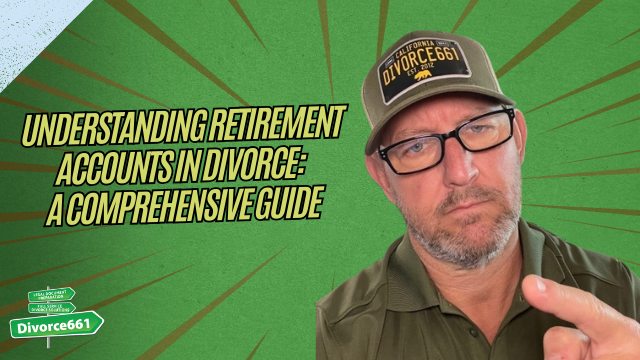Understanding Retirement Accounts in Divorce: A Comprehensive Guide
Divorce can be a complicated and emotional process, especially when it comes to dividing assets like retirement accounts. In California, retirement accounts earned during marriage are typically split 50/50. This includes 401(k)s, pensions, and IRAs, even if only one spouse’s name is on the account. Understanding how these accounts are divided is crucial for securing your financial future during a divorce.
The Basics of Retirement Accounts in Divorce
In California, the law treats retirement accounts as community property, meaning both spouses have a claim to them if they were earned during the marriage. This division can be straightforward, but not all retirement accounts are divided in the same way. Some require specific legal processes to ensure a fair and equitable distribution.
Types of Retirement Accounts
There are various types of retirement accounts that may be subject to division in a divorce:
- 401(k) Accounts: Employer-sponsored retirement savings plans that allow employees to save and invest a portion of their paycheck before taxes are taken out.
- IRAs (Individual Retirement Accounts): Personal retirement accounts that individuals can fund with pre-tax or after-tax dollars, depending on the type of IRA.
- Pensions: Employer-sponsored plans that provide a fixed monthly benefit upon retirement, which can be complex to divide.
- Profit-Sharing Plans: Plans that allow employees to share in the profits of the company, often based on a percentage of their salary.
- Employee Stock Ownership Plans (ESOPs): Plans that give employees ownership interest in the company, which can also be divided in a divorce.
The Importance of a Qualified Domestic Relations Order (QDRO)
Not all retirement accounts require a QDRO, but many do. A QDRO is a legal order that outlines how retirement benefits will be divided between divorcing spouses. It’s essential to understand when a QDRO is necessary to ensure that the division of retirement accounts is executed correctly.
Why Timing and Paperwork Matter
Proper timing and documentation are critical in the process of dividing retirement accounts. Delays in filing a QDRO can lead to missed benefits or complications. It’s advisable to involve a QDRO attorney early in the process. They can help ensure that everything is filed correctly and on time, preventing potential pitfalls.
Real-Life Example: Dividing a Pension After 20 Years
Consider a client who faced challenges dividing a large pension after 20 years of marriage. By collaborating with a QDRO attorney, they were able to navigate the complexities of the pension division. This real-life scenario underscores the importance of having professional guidance when dealing with complex retirement assets.
How to Split Retirement Accounts Fairly
When dividing retirement accounts, both spouses should understand their rights and what they are entitled to. Here are some steps to ensure a fair division:
- Identify and List All Retirement Accounts: Make a comprehensive list of all retirement accounts owned by both spouses.
- Determine the Value: Obtain current valuations of the accounts to understand what is at stake.
- Draft Settlement Language: Clear and precise language should be drafted to outline how the assets will be divided.
- Coordinate QDROs: If applicable, coordinate with a QDRO attorney to ensure the necessary orders are in place.
Common Mistakes to Avoid
Dividing retirement accounts can be fraught with complications. Here are some common mistakes to avoid:
- Failing to Include All Accounts: Not listing all retirement accounts can lead to unfair divisions.
- Ignoring Tax Implications: Be aware of potential tax consequences when dividing retirement accounts.
- Delaying the Process: Waiting too long to address retirement accounts can result in lost benefits.
Protecting Your Financial Future
It’s crucial to secure your financial future by acting promptly. At Divorce661, we specialize in helping clients navigate the complexities of dividing retirement accounts in divorce. Our expertise ensures that everything is done legally, fairly, and on time.
Why Choose Divorce661?
Here are a few reasons to consider our services:
- Expert Guidance: We help identify and list all retirement assets accurately.
- Accurate Drafting: Our team drafts settlement language that courts—and plan providers—accept.
- Coordination of QDROs: We ensure that QDROs are correctly filed, so you don’t lose your share.
Need Help? Get a Free Consultation
If you’re facing a divorce and need assistance with dividing retirement accounts, visit Divorce661.com for a free consultation. Our team is here to help you handle the process fairly and legally.
Final Thoughts
Dividing retirement accounts during a divorce can be complex but understanding the process is key to securing your financial future. By working with experienced professionals, you can navigate the intricacies of retirement account division and ensure a fair outcome. Don’t wait until it’s too late—act now to protect your interests.










